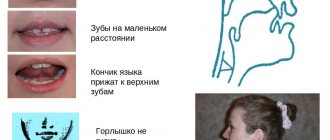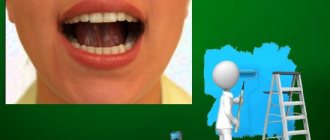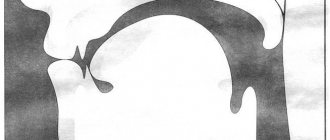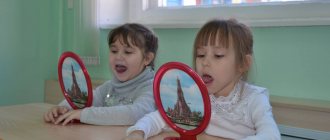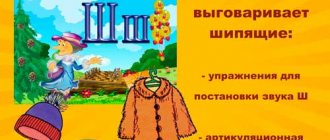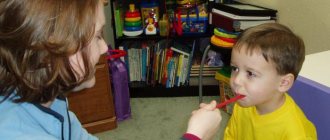Hello, dear readers! Do you know such dishes that do not break, do not break and wash themselves? “Probably some kind of nano-ware or just disposable” - you will think, and you will be wrong, because there is such a cup (C) that is always with us and has all these properties, this is an articulation exercise cup. And it is done with the tongue (I), if you don’t know how, I will teach you. The main thing is desire, patience and a lot of effort - and you will get the best h in the world.
What is the exercise for?
This exercise is very important for staging and automating many sounds. Therefore, all those who want to speak clearly, beautifully and without mistakes cannot do without it. And making hissing sounds in general is problematic if the child does not know how to fold the tongue in the right way, if it looks like a bun and the air spreads from its sides along the cheeks, and does not go out to the front teeth, as it should be normally.
In order to mold a “cup” from a “bun” you need to relax your tongue well and have visual control over the process. Therefore, it is advisable that there is a mirror of sufficient size in front of the child, allowing him to see the reflection of his face, and it is better if an adult also fits there, so that the child can see “how to do it correctly” and compare it with what he can do.
Despite its apparent simplicity, the exercise actually requires a combination of proper muscle function, their sufficient flexibility with a precisely directed air stream, which is regulated in strength and duration. I will talk about the combination itself in an article devoted to the production of hissing sounds; here we will only talk about how to achieve the desired shape of the Self and its mobility.
How to learn to do it?
There are several ways to learn how to do Ch, all of them are based on relaxing certain parts of the Self. At the same time, we do speech therapy massage, as well as self-massage of the Self. One of the simplest: put a wide, soft Self on the relaxed lower lip, then ask the child to “cup the tongue.” Show yourself what it should look like.
Very often the baby cannot do this, then you need to show how to “make a hole” with your finger, resting it in the middle and stepping back a little from the tip. I have to reflexively form a cup. If this does not happen, then the tone of the Self is broken and this needs to be corrected. As I already wrote above, massage (there will be a separate article about it) and self-massage, it is available to everyone, the main thing is to do it carefully and not damage the mucous membrane.
Self-massage techniques are very easy and accessible, the main thing is to use them in such a way that they do not cause negativity in the child. Sometimes the process can take a long time, especially with dysarthria. You need to be patient and come up with a large number of gaming techniques. And don’t forget about sanitation and hygiene, keep your hands clean, rinse your mouth before and after classes, use handkerchiefs or gauze pads so that there is no direct contact with the surface.
Dynamic gymnastics for children
- fence - pipe (frog - elephant)
- open and close your mouth, slap your lips, making a soft sound
- “air kiss”, we stretch our lips forward (as for a kiss) - then we retract our cheeks so that the corners of our mouth touch, like a fish’s
- bite the upper lip, then the lower, “comb your lips”
- smile - tube
- the house is open - closed, close your lips, straining them, open your mouth wide, relaxing, show first the upper lips, then the lower ones, then all at once, a fence
- make faces - move your jaw left and right
- snout - tube
- window - house open - tube - fence - O - A - U - I
- charge for the trunk, twist the tube clockwise and counterclockwise, up and down, left and right. Look at the elephant, how it moves its trunk.
Self-massage
Everyone starts with the “pancake” exercise, with the mouth wide open. First, we simply hold the I in this position for a count of 10. Then we slap the I with our lips “five-five-five” and our teeth “cha-cha-cha”, “combing” the I. We move it forward and back between the closely pressed teeth. Or we scratch it using the “slide” exercise. We “eat” the tongue - we move it back and forth between the teeth, biting it, as if we were first “chewing” it, then pushing it out of the mouth.
We make the I as wide as possible and bite his sides, either left or right. It is best to do this under the supervision of a specialist to avoid injuries and complications. You can also simply pat the protruding I lightly with your hands so that it becomes flatter and wider. In order for the baby to remember the sensations of the wide Self, it is necessary to contrast either the narrow or the wide Self. Fixing attention on how pleasant it is when the Self is relaxed and wide.
Combination and sequence of different types
The sequence is as follows: an adult and a child sit in front of a mirror, the adult points to himself, asks him to repeat, if the child does not succeed, the adult does it for him with his fingers, then the child tries to do it himself, and then tries to do it without using his hands. This is already active gymnastics, maybe not right away, periodically helping with your fingers. The main thing is not to rush, the execution must be precise and correct, so that later you don’t have to relearn.
Passive gymnastics is closely related to massage, or rather, massage smoothly flows into passive gymnastics. You need to clearly know that all exercises must be performed by first relaxing G. You cannot do them with tightly closed, tense muscles. And there will be little use and the child will experience discomfort and negativity, and may refuse to study altogether.
To begin with, it is advisable to teach your child to feel the difference between tense and relaxed lips, to tell him: “You feel how pleasant and good it is when your lips are soft, how beautiful they are.” Fix his attention that when the Gs are tense, they are thin, pale, and when relaxed they are bright, “bow-like”. When making sounds, it is very important that neither the jaw nor the lips tense. The mouth was wide open, otherwise it would be very difficult to work on correcting phonetics.
During static gymnastics, Gs are held in one position for some time, for example, counting to 10. The “tube” exercise is performed, the children hold it, and you count. And so several times, then “fence” and again keep in this position. With dynamic gymnastics, on the contrary, there is an active work of G, “fence - tube”, you need to work G, either stretching them and showing your teeth, or pulling them forward into a tube, also counting in several steps.
Move on to dynamic gymnastics when each exercise has already been practiced, is automated, and the child does it flawlessly. It is allowed to help with your hands, if a malfunction suddenly occurs, it can be combined with voice gymnastics, pronounced with a tube U, and with a fence I at different tempos, sometimes quickly, then slowly, then quieter, then louder, then in a thin voice, then in a “thick” one.
Passive gymnastics
And we move on to passive gymnastics, when the Self is given the desired shape with the help of hands. If the child is already more or less able to expand the tip of the I, then we take it and slightly turn it back. It’s better from the “tongue tube” exercise, when the baby starts to unroll it, we try to wrap the tip. After the h begins to turn out, it is necessary to achieve its stability and lability. The most important thing is to move it behind the upper teeth.
This is very easy, but only on the condition that there are no malocclusions or dystonia. In such cases, the jaw “breaks.” We have to re-work the I position in the H shape, but this time in the form of a “sail” exercise.
Articulation gymnastics “tea party”
We drink tea with sweets, pancakes, jam, sweet straws, and blow on tea.
- pancake - cup (we place a wide tongue on the lip, then wrap the tip in the shape of a cup)
- calyx - tube (we fold the tongue either into a tube or into a cup)
- candy - cup (we suck the tip of the tongue to the upper lip - cup)
- honey - calyx (tongue “stuck" to the upper lip - calyx)
- jam - a cup (we lick the upper lip from top to bottom, then left and right)
- cup - toffee (I in the shape of H rises up by the teeth, as if it wants to remove the glued toffee (chewing gum) from there)
- blow on tea - a cup (tapped the lip “five-five-five”, blew on tea, drank a cup)
After the child has learned to hold the Ch well, and also easily move into a tube and raise it like a “sail,” then it is quite possible to move on to the production of the upper sounds: D - T, hissing, sonors. Add breathing exercises that help you practice the direction of the blown air stream strictly in the middle. I will tell you about this in separate articles on setting R, Sh and breathing exercises.
And this is where I end this article, write your questions and comments in the comments. Share your impressions on social networks with friends and acquaintances.
Articulation gymnastics from a speech therapist, exercises for the tongue
Instructions for performing articulation gymnastics
1. It is necessary to carry out articulatory gymnastics in such a way that you can see how each child performs each exercise.
- The teacher talks, using game techniques, about the upcoming exercises.
- Shows how to perform this exercise.
- All children do the exercise.
- The teacher checks the completion of the exercise in subgroups (no more than 5 people).
2. If children do not perform an exercise well enough, the teacher does not give new exercises, but practices old material.
3. If the teacher sees that the group is mostly coping with the exercise, and only some children are not doing it well enough, he does additional individual work with them or instructs parents to practice this movement at home, allotting 2-3 minutes to complete it. daily.
4. For one lesson, take 4-5 exercises for 10-15 minutes.
5. When performing articulatory gymnastics, it is necessary to ensure that the movements of each organ of the articulatory apparatus are performed symmetrically in relation to the right and left sides. If a child’s tongue or lips deviate to the left or right, then it is necessary to practice these movements individually, in front of a mirror. Fomicheva M.F. "Education of correct pronunciation in children."
The importance of gymnastics for the language
- Strengthening the muscles of the tongue.
- Practicing correct tongue movements.
- Developing the ability to master the tongue by correctly changing its position and quickly finding the desired position.
- Preparation for correct pronunciation of speech sounds.
Exercises for the tongue (to prepare for the pronunciation of whistling sounds: s, z, ts).
“Needle” - stick your tongue far forward, tense it, make it narrow. Hold for 10-15 s. “Spatula” - stick out your wide tongue, relax it, smack your lips, and place it on your lower lip. Hold for 10-15 seconds..
“Swing” - open your mouth, stick out your tongue. Reach your tongue alternately to your nose and then to your chin. Place your tongue in your mouth. Stretch your tongue either towards the upper or lower incisors. Perform for 10-15 seconds.
“Snake” – open your mouth. Push your tongue forward and move it deep into your mouth (10-15 seconds).
“Who will kick the ball further?” – blow from a wide tongue onto a piece of cotton wool or paper so that it moves across the table (5 times).
“Gorka” - mouth open. The tip of the tongue is behind the lower incisors. Raise the back of the tongue upward. There is a groove in the middle of the tongue (a groove can be made by placing a match in the middle of the tongue). Hold for 10-15 seconds. Blow along the “slide” - the sound “ssss” appears.
“Reel” - mouth open. The tip of the tongue is behind the lower incisors. The tongue is wide. The tongue “rolls out” forward and retracts into the mouth (like a coil) 10-15 times. (First the large coil, then the small one).
“Pump” - breathe through your nose with your mouth open (the tongue reflexively curves in a “slide”). Then “blow” along the curved tongue (10-15 seconds).
“Tube” - roll the tongue into a tube, bending its edges (10-15 sec.).
“Chick in the nest” - the mouth is open, the tongue lies quietly in the mouth (10-15 sec.).
“Who will blow the loudest?” - blow from the tongue onto a strip of paper held vertically near the lips so that it deviates (5 times).
“Don’t make noise” - say “ts-ts-ts-ts-ts-ts”, putting your finger to your lips (10 - 15 times). “Let’s brush your teeth” - use the tip of your tongue to move the bottom teeth up and down from the inside (10-15 seconds).
“Sweeping the floor” - arch your tongue, move the tip of the tongue forward to the lower incisors and back into the depths of the oral cavity (10 - 15 sec.). “The cat is angry” - smile, open your mouth. On the count of “one”, arch your tongue, resting the tip on your lower teeth. On the count of two, return to the starting position. “Stubborn donkey” - lips in a smile, mouth slightly open. Pronounce the sound combination IE with force. The tip of the tongue rests against the lower teeth (10–15 sec.).
“Strong tongue” - forcefully press the tip of the tongue against the lower incisors, arching the tongue in a hill (10 - 15 sec.).
“Monkey” – place the tip of your tongue under your lower lip and hold for 10 – 15 seconds. “Delicious jam” - the movement of “licking” with the tip of the tongue from the lower lip into the oral cavity behind the lower incisors (10 - 15 sec.). “Lick the spoon.” Licking the spoon from bottom to top, the tongue arches into a slide. (10-15 times). "Hide and seek." (Hide the tongue so no one sees it.) The tongue moves back. The tip of the tongue is located down. (10-15 times). "Hockey". The tongue is the stick, the vitamin is the puck, the mouth is the field. The puck (vitamin) needs to be driven across the field (in the mouth) with a stick (tongue). (10-15 sec). "Coughs." When coughing, the tongue reflexively curls up (10-15 times). “Let’s warm our hands” - say: “Х-Х-Х”, while directing the air stream onto the palms. The tongue reflexively curls up. (10-15 times). "Beep." Say: "Uh-oh." The tongue reflexively curls up. (10-15 sec). "Comb". The tip of the tongue rests on the lower gum. “Combing” the back of the tongue with teeth. (The tongue rolls out like a “coil”). (10-15 sec).
Exercises for the tongue (to prepare for pronunciation R).
“Swing” - open your mouth, stick out your tongue. Reach your tongue alternately to your nose and then to your chin. Place your tongue in your mouth. Stretch your tongue either towards the upper or lower incisors. “Snake” - open your mouth, push your tongue forward and move it deep into your mouth (10-15 times). “Needle” - stick your tongue far forward, tense, make it narrow (10-15 sec.). “Spatula” – stick out your wide tongue, relax it, smack your lips, and place it on your lower lip (10-15 seconds).
“Horse” - suck your tongue to the roof of your mouth, click your tongue. Click slowly, firmly. “Mushroom” – suck your tongue to the roof of your mouth, open your mouth wide (10-15 sec.). “Delicious jam” - stick out your wide tongue, lick your upper lip from top to bottom and remove your tongue (10-15 times). “Painter” - slow movements with the tip of the tongue across the palate from the upper incisors to the “neck” and back (10-15 times). “Who will kick the ball further?” – blow from a wide tongue onto a piece of cotton wool or paper so that it moves across the table (5 times).
“Breeze” - blow from the tongue onto a strip of paper held vertically near the lips so that it deviates (5 times).
“Glue the candy” - with the wide tip of your tongue, touch the tubercles in your mouth located behind the upper incisors (10-15 seconds). “Monkey” – place the tip of your tongue under your upper lip and hold for 10 – 15 seconds. “Strong tongue” - forcefully press the tip of the tongue against the upper incisors (10 - 15 s). “Let’s brush your teeth” - use the tip of your tongue to move along the upper incisors from the inside down - up (10 - 15 sec.).
“Turkey” - a) with the wide tip of the tongue, quickly move the upper lip back and forth, b) behind the teeth, quickly move the tongue back and forth (10 - 15 sec.). “Drummers” - we quickly say “d-d-d”, exhaling the air strongly for the last time. “Motor” -1) pronounce “zh” with your mouth open and rotate your arms in front of your chest, 2) pronounce “zh” with your mouth open and touch your tongue with your finger (10–15 s). “Balalaika” - the tip of the tongue - up behind the teeth, touch the tongue with your fingers a) without a voice; b) with voice (10 – 15 sec.).
“Kucherskoe “tpru”” - (an exercise to develop air pressure and vibration of the tongue). Spread your tongue wide and place it on your lower lip. Blow air forcefully so that your tongue vibrates. The tongue and lips are not tense, relaxed (If this doesn’t work, first try to close your relaxed lips and blow out air strongly, causing your lips to vibrate (with your voice)). Then perform the “coachman’s “tpr”” again (10-15 sec.).
“The horses are galloping” - quickly say “td-td-td-td”, touching your tongue with your finger each time (10 - 15 sec.).
“Fork” - to avoid strong vibration of the edges of the tongue, hold the tongue from the sides with your fingers: put 2 fingers under the tongue, press it from below to the molars. We use it when performing the “Horse” exercise, when pronouncing [rr-r-r]. “Learning to play the harp” - say “d-d-d-d”, each time touching your tongue with your finger. “Let's score the ball” - the mouth is closed, the elastic tongue rests on one or the other cheek. “We shoot” - we slowly pronounce: “j-j-j”, exhaling air strongly, trying to make the tongue tremble (10 - 15 sec.). “We play the harp” (or “start the engine”) - slowly move the tongue behind the upper incisors “drl-drl-drl” (10 - 15 sec.). “Dragonfly” - say “tr-rr-r” in a whisper, and then loudly (10 - 15 sec.).
Exercises for the language (to prepare for pronunciation L).
“Delicious jam” - extend your tongue, lick your upper lip from top to bottom and remove your tongue (10-15 times). “Spatula” – stick out your wide tongue, relax it, smack your lips, and place it on your lower lip (10-15 seconds). “Needle” - open your mouth, stick your tongue far forward, tense it, make it narrow. “Horse” - suck your tongue to the roof of your mouth, click your tongue. Click slowly, firmly. “Mushroom” – suck your tongue to the roof of your mouth, open your mouth wide (10-15 sec.). “Swing” - stick out your tongue, stretch your tongue alternately to your nose, then to your chin; put your tongue in your mouth, leave your mouth open, stretch alternately to the upper and lower incisors. “The steamer is humming” - pronounce “y”, lift the tip of the tongue over the upper incisors, continue to hum “l-l-l” (“y-l-y-l”). “Snake” - open your mouth, push your tongue far forward and move it deep into your mouth. Slowly (10-15 times).
“Painter” - use the tip of the tongue to move across the palate from the upper incisors to the “neck” and back. Slowly (10-15 times). “Glue the candy” - use the tip of your tongue to touch the upper incisors on the inside, hold your tongue in this position (10-15 seconds). Honk "l-l-l."
“Cycle” – open your mouth, make a “cup” of your tongue, bend its edges and tip (10-15 sec.). Move the cup up behind the teeth, connect the voice “l-l-l-l-l” - “The steamer is humming.” “Tube” - roll the tongue into a tube, bending its edges (10-15 sec.). “Chick in the nest” - the mouth is open, the tongue lies quietly in the mouth (10-15 sec.).
“Drinking dewdrop” - the upper lip is a flower petal with dewdrop. You need to “drink” the dewdrop (suck the edges of your tongue to your lip, leave a gap in the middle of your tongue, and suck the air into yourself; gradually remove the tip of your tongue into your mouth behind your upper teeth.). “Fork” - if the air does not flow through the center of the tongue, but between the lateral edges of the tongue and the cheeks, then lift the wide tongue by the upper incisors, stroke the lateral edges of the tongue and press it with your fingers to the molars (fingers are the “fork”).
“Turkey” - touch the upper lip with the tongue (slowly), then remove the tongue behind the upper incisors and touch the tubercles (10 - 15 sec.).
“Breeze” - blow from the tongue onto a strip of paper held vertically near the lips so that it deviates (5 times).
“Focus” – place a piece of cotton wool or paper on the child’s nose. The child must blow it off his wide tongue (5 times).
“The plane is humming” - hold the tip of your tongue between your teeth and hum “l-l-l-l-l”. You can straighten your arms and “fly” around the room. “Learning to hum” - 1) clench your teeth, press the tip of your tongue against the upper incisors from the inside, hum “l-l-l”; 2) say “n-n-n”, hold your nose, continue humming (the air will go through the mouth, you will get “l-l-l”) (10 - 15 sec.). “Push out the teeth with the tongue” - firmly press the tip of the tongue against the upper incisors from the inside and hum “l-l-l-l-l” (10 - 15 sec.).
Say “zh-zh-zh”, press your tongue more tightly to the palate (with a finger or probe, the tip of a spoon), continue to hum “l-l-l” (10 - 15 sec.). “Monkey” – place the tip of your tongue under your upper lip and hold for 10 – 15 seconds. “Strong tongue” - forcefully press the tip of the tongue against the upper incisors (10 - 15 s). “Let’s brush your teeth” - use the tip of your tongue to move along the upper incisors from the inside down - up (10 - 15 sec.).
Exercises for the tongue (to prepare for pronouncing hissing sounds: sh, zh, ch, shch).
“Spatula” – stick out your wide tongue, relax it, smack your lips, and place it on your lower lip (10-15 seconds). “Needle” - tense your tongue, make it narrow (10-15 sec.). “Swing” – 1) open your mouth, stick out your tongue. Reach your tongue alternately to your nose and then to your chin. 2). Place your tongue in your mouth. Stretch your tongue alternately to the upper and lower incisors (10-15 times).
“Snake” - open your mouth. Push your tongue forward and move it deep into your mouth (10-15 times). “Horse” - suck your tongue to the roof of your mouth, click your tongue. Click slowly, firmly (10-15 times). “Mushroom” – we suck the tongue to the palate, opening the mouth wide (10-15 sec.). “Delicious jam” - stick out your wide tongue, lick your upper lip from top to bottom and remove your tongue (10-15 times).
“Painter” - movements of the tip of the tongue across the palate from the upper incisors to the “neck” and back. Slowly (10-15 times). “Glue the candy” - with the wide tip of your tongue, touch the tubercles in your mouth located behind the upper incisors, hold your tongue in this position (10-15 seconds).
“Who will kick the ball further?” – blow from a wide tongue onto a piece of cotton wool or paper so that it moves across the table (5 times).
“Breeze” - blow from the tongue onto a strip of paper held vertically near the lips so that it deviates (5 times).
“Focus” – place a piece of cotton wool or paper on the child’s nose. The child must blow it off his wide tongue (5 times).
“Cycle” - open your mouth wide, make a wide tongue into a “cup”, bending its edges and tip (10-15 sec.). Later, put the “cup” in your mouth, behind the upper incisors, and blow – a sound will appear. “Tube” - roll the tongue into a tube, bending its edges (10-15 sec.). “Chick in the nest” - the mouth is open, the tongue lies quietly in the mouth (10-15 sec.). “We clean our shoes with a brush” - say “chsh-chsh-chsh-sch-sch-sch” (10-15 seconds). “Monkey” – place the tip of your tongue under your upper lip and hold for 10 – 15 seconds. “Strong tongue” - forcefully press the tip of the tongue against the upper incisors (10 - 15 s). “Let’s brush your teeth” - use the tip of your tongue to move along the upper incisors from the inside down - up (10 - 15 sec.).
“Drinking dewdrop” - the upper lip is a flower petal with dewdrop. You need to “drink” the dewdrop (suck the edges of your tongue to your lip, leave a gap in the middle of your tongue, and suck the air into yourself; gradually remove the tip of your tongue into your mouth behind your upper teeth.). “Fork” - if the air does not flow through the center of the tongue, but between the lateral edges of the tongue and the cheeks, then lift the wide tongue by the upper incisors, stroke the lateral edges of the tongue and press it with your fingers to the molars (fingers are the “fork”).
List of literature used in the compilation of articulatory gymnastics.
- Fomicheva M.F. "Education of correct pronunciation in children." - M., 1989
- Khvattsev M.E. "Speech therapy". - M., 1959
- Lopatina L.V. “Speech therapy work with preschool children with minimal dysarthric disorders: Textbook.” / Ed. E.A. Loginova. – St. Petersburg: Soyuz Publishing House, 2005.
- Seliverstov V.I. "Speech games with children." – M.: Vlados, 1994.
- Methods of speech development for preschool children/ L.P. Fedorenko, G.A. Fomicheva, V.K. Lotarev, A.P. Nikolaicheva. – M.: Education, 1984.
- BEHIND. Repina, V.I. Buyko "Lessons in speech therapy." – Ekaterinburg: Publishing house. "Litur", 2002
- N.V. Novotortseva “Workbooks on the development of speech using sounds...”. – Yaroslavl: Academy of Development, 1996.
- Bogomolova A.I. “Speech therapy manual for classes with children.” – Bibliopolis Publishing House LLP. St. Petersburg, 1994
- M.A. Povalyaev "Speech therapist's reference book". – Rostov-on-Don: “Phoenix”, 2002
- G.A. Volkova “Logorhythmic education of children with dyslalia.” – St. Petersburg, 1993
- R.I. Lalaev “Speech therapy work in correctional classes.” – M.: Humanite. ed. Vlados center, 1999
Also on topic:
logoped18.ru
